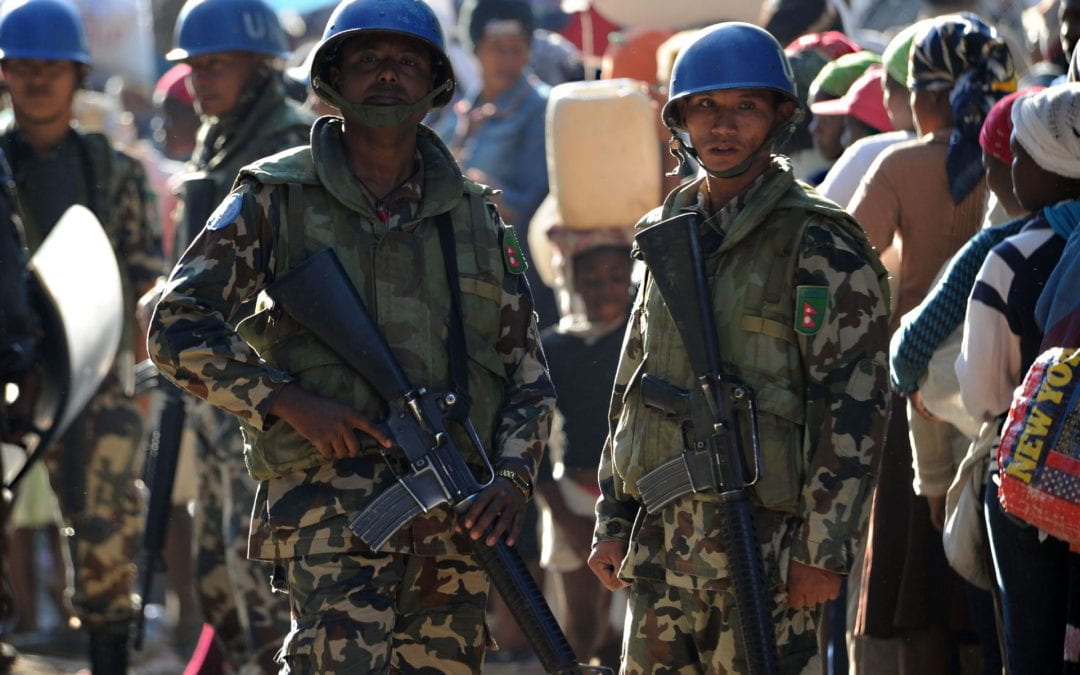By James Crossland
James Crossland looks at the history of humanitarians under attack.
The evacuation of 422 White Helmet volunteers from Syria seemingly marks the end of a daring five-year humanitarian mission in one of the world’s most war torn countries. Founded and initially trained by a retired British officer and comprised of local recruits, the White Helmets (AKA the Syrian Civil Defence) were formed in 2013. Their aim was to carry out search and rescue operations for victims of bombings in rebel held areas of Syria.
The White Helmets, who claim to have saved the lives of more than 100,000 people, stand as a beacon of light for much of the international community amid the darkness of the Syrian civil war. They have becoming the subject of an Oscar-winning Netflix documentary and earned a Nobel Peace Prize nomination in 2016.
But this rosy picture of humanity at its best has been tainted by the politicisation of the outfit’s activities and the establishment of a counter narrative in which the volunteers appear as anything but battlefield angels.
Propaganda and smear campaigns
The White Helmets have been demonised by Russian-backed propaganda outlets as everything from being partial to the rebel cause (despite the group’s motto being “to save a life is to save all humanity”) to collaborating with ISIS, to staging chemical weapons attacks, to simply being an all-purpose front for unofficial Western meddling into Syrian president Bashar Al-Assad’s affairs.
The latter claim, in particular has been repeated in press outlets sympathetic to the Syrian president, which reference the fact that the White Helmets have been funded primarily by Western governments.
Aside from this smear campaign, the White Helmets have also been the victims of more direct action. This has included the bombing of several of their hospitals and, most unambiguously, a midnight raid on one of their safe houses in August 2017 in which seven of the volunteers were executed by assassins still unknown.
This might read like chapters of a modern war thriller – indeed, the tale of the White Helmets is scheduled to become a George Clooney-led film.
Wartime humanitarianism
So much of their experience is neither new nor unique. The triumphs, travails and tragedies of the White Helmets are just the latest instalment in the long, brutal story of wartime humanitarianism which stretches back over 150 years. Similar tales were played out on the battlefields of the Franco-Prussian War (1870-1871) and the Balkans Uprisings (1875-1878). Both involved cases of clearly identified humanitarians being targeted for violence and having their motives questioned.
In these instances, it was not White Helmets, but Red Crosses and Red Crescents that distinguished the volunteers from the fighters. They were the symbols enshrined by the articles of the Geneva Convention as indicating the neutrality of battlefield medics. But these “sacrosanct” symbols did not protect the volunteers from suspicion and attack.
Red Cross hospitals were routinely shelled throughout the Franco-Prussian War. During the siege of Paris a number of volunteers were shot in the belief that they were using their “neutral” Red Cross status as a cover for committing acts of espionage. Like the White Helmets of today, the idea that volunteers could act in the service of all war’s victims raised eyebrows.
The Swiss volunteer, Frédéric Ferrière was imprisoned on suspicion of being a spy, despite offering his medical services to the “enemy” Prussians.
The French volunteer nurse, Coralie Cahen, was also forcibly ejected from a camp by Prussian troops when she tried to gain access to starving prisoners of war, testament to how – then as now – humanitarians’ actions were also politicised. Cahen was later lauded by the national press as a symbol of French humanitarian spirit triumphing over Germanic barbarism.
Contemporary questions over the White Helmets’ funding and motive are also nothing new. During the Balkans Uprisings of the 1870s, a British organisation called the Stafford House Committee sent a humanitarian mission to the troubled region. Although serving under the Red Cross and Red Crescent – and therefore supposedly impartial – Stafford House’s volunteers were characterised in the press as medical mercenaries acting in favour of the Turkish army and taking gold from the Sultan and pro-Turkish backers in Britain.
The grounds for these accusations were far firmer than those currently being thrown at the White Helmets. But the fact remains that the murky grey area between political agendas and “neutral” humanitarian action has always existed, along with slur campaigns and violence from those who are threatened by the work of humanitarian volunteers.
In this sense, the White Helmets’ evacuation from Syria may mark the end of their individual story. But, if history is any guide, the sobering and sadly familiar aspects of their tale will continue elsewhere in future.
This article was originally published on The Conversation and has been republished under a creative commons license. For the original, click here.
James Crossland is a Senior Lecturer in International History at Liverpool John Moores University.
Disclaimer: The ideas expressed in this article reflect the author’s views and not necessarily the views of The Big Q.
You might also like:

